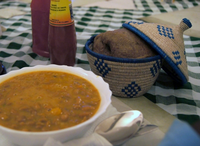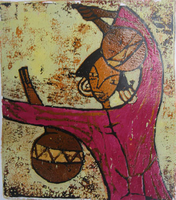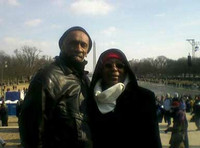
A new report produced by the University of Illinois Chicago in conjunction with workers’ rights groups paints a startling picture of the inequity experienced by many of the immigrants doing the hard, often dangerous work of rebuilding. Many have experienced wage theft, the majority have had no safety training and workers are rebuilding without access to basic safety equipment.
Already, battle lines are being drawn between a vision of equitable reconstruction being driven by worker’s rights groups and their allies in the Houston government and a free market vision championed by the Trump administration and their Republican allies in the Texas state government.
More than a decade after Katrina, immigrant and workers groups say that they have learned the lessons of storm recovery and are applying them to a massive political movement being launched under the banner of Houston Rising Coalition.
“Black workers were primarily excluded from rebuilding efforts and had to fight their way in while immigrants workers, while included, suffered extraordinary exploitation” said Saket Soni, executive director of the National Guestworkers Alliance, who headed the New Orleans Workers’ Center after Katrina.

As much as people from the Northern, Eastern and Western regions of Uganda may differ culturally, when it comes to the dining table where millet bread is served, they all become united as one. For many years, millet bread has been the main food of the day for people in these regions.
[Ed.: This is the first contribution by our Uganda correspondent Emily Kembabazi. We look forward to more articles. We welcome submissions on topics of mutual trans-Atlantic interest.]
This delicious meal has a variety of names in the different tribes and regions. For instance among the Bakiga, Banyankole, Batooro and Banyoro in the western region, it’s called akaro /oburo whereas among the Bacholi and the Luo in the Northern region, they call it kal. In the Eastern region, the Bateso tribe calls it atap and obwiita among the Basoga.
The Baganda in the central region also call it akaro and this is the only region in the whole of Uganda where millet bread is rarely the meal of the day.
Some researchers have it that millet bread originated from the tribes of northern Uganda during the Gipiiri and Labongo Luo migration before spreading southwards. The akaro is extracted from dried millet grains by using either the traditional grinding stones or modern ways of grain milling.
According to Fellydath Bagamba from western Uganda, millet flour is often not considered suitable for a meal unless cassava flour is added to it. The difference in taste, aroma and appearance of this dish is determined by the proportions in which the flours are mixed. The cassava flour element brings both a sticky and a soft texture making the mixture relatively easy to prepare.
Uganda's telecommunications companies serve more than 19.5 million mobile subscribers out of an estimated population of 36 million, a 52.3 percent penetration rate according to the Uganda Communications Commission (UCC) as of December 2014.
Rage et.al (2011) reported that Uganda was ranked among the top ten African countries with the highest number of mobile phone subscribers and that MTN and Airtel Uganda have the biggest share with more than 17 million users split in between them. While Maestas (2013) has it that a huge part of the population has not just one cell-phone but always two and sometimes more.
Meanwhile, Freedom house (2014) reported that internet penetration in Uganda had grown steadily following the deregulation and liberalization of the information and communications technology sector in 1997 which ushered in a reduction in mobile telephone tariffs and bandwidth prices.
During the 1930s in Uganda, there were clan heads locally known as Abatikyiri. These were leaders who were extremely respected due to the positions they held. Clan heads were not supposed to travel long distances on foot for administrative purposes. For this reason, the clan heads came up with a solution that would ease their transportation from one place to another.
As a result, people started gathering bamboo trees and other plant species to make a stretcher commonly known as ‘engozi’ wherein the Omutikyiri, carried by slaves, would sit comfortably with a calabash filled with local porridge to drink while on a journey.

A 911 call reporting the fire at Hopewell Baptist Church in Greenville came in at about 9:15 p.m. Tuesday, police said. Firefighters quickly extinguished the blaze.
Most of the damage to the 111-year-old church was to the sanctuary, pastor Carilyn Hudson said at a news conference.
As of this review the investigation is continuing. We've also learned that the public has contributed much more than will be need for rebuilding. One assumes that Christians will have no trouble recruiting carpenters.
(Readers are encouraged to register and comment. Attacks on political personalities are probably useless, but if you can volunteer to help this community rebuild, give them at least a kind word. -Ed.)
The report’s findings, which will be presented at the June conference of the National Association of Black Accountants Conference in Nashville, Tennessee, found that the African American population is an economic force to be reckoned with, with a projected buying power of $1.1 trillion by 2015.

The program will grow affordable, organic herbs, fruits and vegetables all year round. The fundraiser is the first in a series of events that will highlight the importance of our communities' access to fresh affordable organic fruits and vegetables.
The program grew from a senior project at Evergreen State University by founder Michael Twiggs of Seattle, who is also one of the publishers of AABL.
How does "urban farming" work? Consider the standard process of food production and delivery. Raw produce travels to a factory, where it is processed. The processed food is then warehoused for an unknown period. It is then distributed to food stores, where it may again be stored. Finally you buy it for your family. In this long chain of events, nutrition is inevitably lost.
The GOE model puts food production right into your neighborhood. You buy either from the producer or a nearby retail outlet. This means your produce is fresh and retains most of its original nutritive value.
This does not mean your supermarkets cannot offer this better nutrition. Just ask them to carry local produce along with their regular offerings. Your thoughtful purchases will make the difference.
The program was introduced in 2012 at a kickoff presentation hosted by Tacoma, WA, Mayor Marilyn Strickland, who has endorsed the program along with Dr. Maxine Mimms, a prominent local educator.
There are many advantages of urban hydroponics, according to Twiggs, including a year–around growing cycles as a sustainable business model, new technologies for growing organic foods at much lower cost , new work opportunities for local residents and the impact on our communities needed economic revitalization.

Art fare includes paintings, sculpture, jewelry, woven and dyed cloth and more to come. Styles include both traditional and modern, with even the modern media assuming a strong East African cultural form. A growing number of examples may be seen at the gallery link below.
The impetus for the project came from US teacher Tom Herriman, a retired publisher and former Teamsters organizer who spent a semester in suburban Namsana near Kampala teaching language and music to children 10-16. Herriman's web host, Clark Internet Publishing, agreed to establish and operate the web site at cost plus basis, with all fees deferred until the project is financially self-sustaining.
(Clark Internet also hosts and partners with AABL.com.)

Organizers underscored the importance of voting in the Jan. 3, 2008 primary even though people of color make up less than six percent of the Iowa population.
By category, here are their picks.
* Politics: Barack Obama
* News: Oprah Winfrey
* Music: Jay Z
* Business: Russell Simmons
* Entertainment: Tyler Perry
* Sports: Tony Dungy and Lovie Smith
Do you think they got it right? Comment or add your picks in the Forums.
They write "Getting back to business after a disaster depends on preparedness planning done today. Small business owners invest a tremendous amount of time, money and resources to make their ventures successful, and yet, while the importance of emergency planning may seem self-evident, it may get put on the back-burner in the face of more immediate concerns.
Categories
Recent Posts
- AMA, other medical sources steadfast on positive aspects of vaccination
- "AA" Event planned for Seattle waterfront
- Frederick M. 'Casey' Jones' invention probably brought you today's lunch
- Yusuf Ssali Named New Ex, Dir.
- US Service Organization Assists Uganda Family
- Dinka Culture Transcends Challenges
- Hermona Girmay is Miss Washington 2024
- Kidneys from Black donors more likely to be discarded − why?
- Tillman youngest to earn US PhD
- What It’s Like to Have COVID-19
- Merck CEO Lauds Alliance for J&J Covid-19 Vaccine Manufacturing
- Payroll employment falls, unemployment rises in March
- Regional Prototype under Study
- Uganda Equator worth a visit
- Stone of Karegyeya Worth the Side Trip







